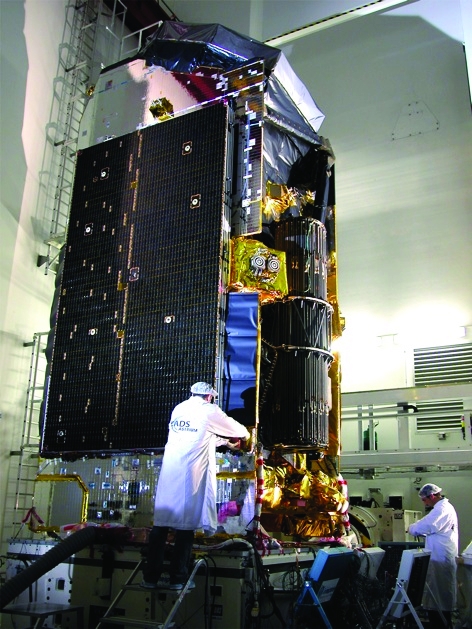In my last post I wrote about the use of composites in the manufacture of satellite antennas. Composites offer a number of structural advantages in spacecraft manufacturing, but of course it is impossible to build a highly sophisticated telecommunications satellite out of just one type of material.
Practically all spacecraft are a mix of intricate electronics, highly sensitive photovoltaic cells, complex propulsion systems and highly stressed structures. Therefore, when building a multi-million pound satellite, one of the biggest challenges for engineers is to prove beyond doubt that it can withstand not only the rigours of space, but also the journey to get there.

To get a satellite into space, the only option is to put it on top of a rocket and blast it into orbit. What many people don’t realise is that this is often when a spacecraft is subjected to the most stress.
To test the launch worthiness of a satellite we have to subject it to mechanical testing. Using electrodynamic shakers and acoustic sirens we can recreate all the internal stresses and high “G” loads experienced in a typical launch. From an acoustic perspective the sirens can reach over 150dB – that’s louder than a jet engine, powerful enough to shatter glass and certainly not safe for human ears!
One of the biggest challenges for engineers is to prove that a satellite can survive the rigours of space and the journey to get there
It’s also necessary to ensure that our satellites can withstand the temperature extremes of space. As part of our test campaign, satellites are subjected to thermal vacuum testing over a series of weeks, which enables engineers to simulate in-orbit temperatures of anything between +160ºC to -180ºC. The fact that this is done in a vacuum is important as, like in space, the transfer of heat through normal convection is not possible.
It’s at this point where we can determine if the satellite’s thermal blankets and internal heat pipes are performing correctly. Remember, despite the vast temperature ranges in space, our satellite’s sensitive electrical systems like to operate at ambient temperature, approximately 20ºC to 27ºC, so it’s a huge engineering challenge to keep the inside temperature of a spacecraft stable.
Finally, the performance of a telecommunications satellite needs to be validated through radio frequency (RF) tests. This is where we can test if a satellite is broadcasting in the way that our customer expects it to when it reaches its final orbit.
We use antenna radiation patterns to confirm that a satellite will provide the required coverage over a distinct geographical area. Although our RF chambers are typically only 30 metres long, reflections off two specially shaped 50 tonne mirrors convert the signals into plane waves as if they were coming from 36,000 Km away – the altitude of the satellite. The entire RF chamber is covered with an absorbent material that resembles a series of blue foam cones - this eliminates unwanted RF signal reflections from other sources to ensure that nothing interferes with the satellite.
The whole testing process can last up to six months, but is absolutely vital when we guarantee our customers a minimum of 15 years continuous performance in space.




Nanogenerator consumes CO2 to generate electricity
Whoopee, they've solved how to keep a light on but not a lot else.